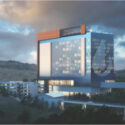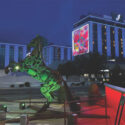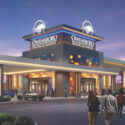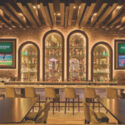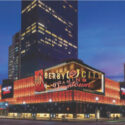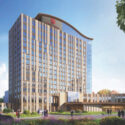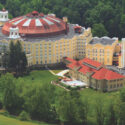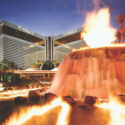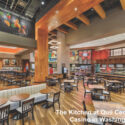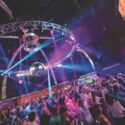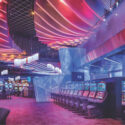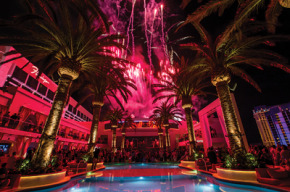
For the past decade, the competition among Las Vegas nightclubs on the Strip has been just as fierce as the World Series of Poker, Mr. Olympia or any Floyd Mayweather boxing match. It is a battle that includes world-famous DJs, packed dance floors, beautiful employees and A-list celebrities.
Despite all of the VIP passes, pretty people and bottle-popping associated with the Las Vegas nightclub industry, the foundation of the entire experience continues to be the particularly unique design of each venue.
“Often in the industry you have clients that come with idea after idea, but they do not have the budget,” says Mike Stewart, director of design for YWS Design and Architecture, which recently designed the wildly popular Hakkasan nightclub at MGM Grand. “In Las Vegas, when you start down the design path, you have to know what you want, from a specific look and feel to a design that helps generate revenue from patrons, as well.”
New & Unique
Creating a design that is comfortable to the millennial demographic is extremely important. Millennials expect a level of “newness” that needs to be reflected in the nightclub. That novelty factor is important because it leads to a more energized and excited customer, who then in turn is more apt to spend more money while visiting the venue.
“When people come to Las Vegas they want to be someone else altogether, and the nightclub experience and design is a very big part of that,” says Clemente Chicoria, lead designer at YWS Design and Architecture, who himself worked in the Las Vegas nightlife industry for five years.
This past May, Drai’s nightclub opened the latest iteration of the legendary brand at the new Cromwell hotel on the Strip. It is getting rave reviews for its design, which features wider walkways, a spacious dance floor and extended bar counter areas, which helps bartenders serve patrons faster, generating more revenue for the club.
“Our design is focused around the overall guest experience and flow,” says Ryan Michael Craig, managing partner and spokesman for Drai’s nightclub. “It is a 360-degree interactive party that showcases the best of what the city has to offer. We looked at our favorite features of the top six or seven clubs from around the world and adapted them to Vegas and our venue. You can see small perfect hints of the best venues when you are at Drai’s.”
The one key design feature that most of the popular Las Vegas nightclubs share is the inclusion of separate indoor and outdoor experiences for patrons. The indoor area fits the needs of dance enthusiasts and people who want to hold down the fort at the bar, while the outdoor area is often preferred by larger groups and smokers.
“I think having an outdoor area and even a pool is extremely relevant for the major nightclubs,” says Terrence Bligen, also known as DJ Direct, one of the most popular DJs on the Las Vegas Strip. “It puts the customers in a happier mood because they love to pop bottles at their table outdoors by water, which means more money for the club. When the crowd is happier the DJ gains confidence and will probably have a better performance that night.”
See & Be Seen
At Château nightclub at Paris Las Vegas Hotel and Casino, there is not a pool like Drai’s or XS nightclub at Encore, but they boast a rooftop nightclub level with over 40 VIP tables for bottle service, as well as an outdoor beer garden level with over 20 VIP tables, both of which are major factors in generating revenue. The rooftop level is under the Eiffel Tower that protrudes through the hotel and overlooks Las Vegas Boulevard and the Bellagio water show.
“In today’s highly competitive market, the ability to offer our guest an indoor and outdoor experience has been a key part of the success of our nightclub,” says Steve Kennedy, owner of Château nightclub. “With Las Vegas having great weather for at least nine months out of the year, the outdoor design of the club helps you retain guests who enjoy the open-air concert.”
The open-air concept is in full effect at Marquee Nightclub and Dayclub at Cosmopolitan, but they recently added a new twist to the outdoor experience with a “dome” feature over the outdoor dayclub, just in time for the winter months.
“We always look for the ‘wow’ factor,” says Noah Tepperberg, TAO Group partner, which operates Marquee. “We believe that guests need to say ‘wow’ at some point during the night, and it is one of those ‘wow’ moments that creates the ‘must see’ buzz around our venues.”
Lights & Sound
Along with multimillion-dollar DJs from across the globe, including everywhere from Scotland to Sweden to San Francisco and everywhere in between, the other element that has put the spotlight on Las Vegas’ nightlife industry are the multimillion-dollar lighting systems that can be found at all of the popular clubs.
At XS, more than 10,000 individual light sources illuminate the club, as the club’s design is inspired by the sexy curves of a human body. The illuminated outdoor pool is a favorite during the summer and blends in with the club’s rich colors of gold, black, bronze and brown.
Château offers a $3 million lighting and sound system equipped with a high-definition LED screen that engulfs the DJ booth. Not to be outdone, Drai’s has over 7000 square feet of LED lighting in a circular design, similar to what can be found at an NBA arena.
“The No. 1 use of technology at these nightclubs is lighting,” says Chicoria. “The integration of light and sound envelops the senses and makes the guests want to stay longer to enjoy the experience. That is always a good thing.”
At Marquee, the contrast between indoor and outdoor club experience is unified by a dynamic lighting display that craves almost as much attention as its world-famous DJs or stunningly beautiful cocktail waitresses and staff.
“I think our attention to technology is part of what separates TAO Group from our competitors,” says Tepperberg. “We thrive on bringing the latest LED, lighting and sound technology to our clubs. A good example of this is the drawbridge LED wall we put into Marquee when we opened four years ago. At the time, not one other club on the Las Vegas Strip had installed a live concert-scale LED wall. Now everyone has one like Marquee’s.”
The sophisticated light systems help transform the nightclubs into multi-purpose venues, whether it be for concerts, promotional parties hosted by conference and convention clients or internal corporate events. This also means more revenue for the venues, especially during traditional slow times during the week and during daytime.
“The nightclub business in Las Vegas is very saturated,” says Kennedy. “You must find something to set you apart from all the other venues.”
A Matter of Music
Over the past five years, electronic dance music (EDM) has been the preferred music format at the popular Las Vegas nightclubs. EDM has its roots in techno dance and house music made popular in Europe during the late
1980s, and domestically in the Chicago and New York City nightclub scenes in the late 1980s and early 1990s. However, this latest chapter of EDM in the United States took a stronghold about a decade ago with rave parties that catered to a younger demographic, usually from 16 to 20 years old.
Now that this generation of partygoers has gotten older, the transition from top 40 and hip-hop music to EDM at the Las Vegas nightclubs was inevitable.
Why the transition? Whereas many popular top-40 dance and hip-hop songs are broken down into multiple beat patterns, EDM often builds up into a chorus of one solid beat pattern, which is easier to follow and has made the dance floor a much more inclusive area for all to enjoy. This explains the nightclub admission lines in Las Vegas that can be as long as a quarter mile. This too, obviously, means more revenue for the clubs.
“EDM has always been a popular music format, and it really blew up four years ago when the DJ war started in Las Vegas,” says Craig. “Like everything in the city, the popular music format cycle is bound to change every three to four years, so our belief is that the overall guest experience is key, and we believe that the DJ is only one of many aspects of the club which make it successful. Rather than take already-established talent, our goal is to take new and up-and-coming talent and grow them into superstars.”
Despite the perpetual cycle of music trends in Las Vegas, it doesn’t appear that the EDM craze is going anywhere anytime soon.
“Marquee was the first club in Las Vegas specifically designed for the EDM genre,” says Tepperberg. “We used to put the most emphasis on the table locations and design the rooms from the orientation of the experience of the table guest, but now we start with the DJ booth and orientate the clubs’ flow and sightlines around the booth.” The connection between the guests, DJ and dance floor is key to maximizing the EDM experience, but was not nearly as important when top-40 dance and hip-hop ruled the Las Vegas nightclub scene.
“I believe that when you walk into a nightclub, the first thing you should see is the DJ and the layout of the venue,” says Bligen. “The design I love to see while playing at a nightclub is being able to view the outside skyline from the DJ booth. Whether I am looking at other casinos, other buildings or just simply the skyline, it gives me a natural high to perform even better. It gives me the impression that all of my hard work has finally paid off and I need to give the crowd the best performance possible.”
Details of the Design
The design of each venue is completely different, although several have similar features. One nightclub that stands out is Hakkasan, because its roots are as a popular restaurant in London, years before it became a popular Las Vegas attraction.
Hakkasan features the use of real materials like glass, stone and wood, where many nightclubs use faux material and rely on dark paint because of the lack of light during operating hours. Stewart says this is common in the nightclub industry and calls it a “big risk” that detriments the quality of the venue.
“The overall brand aesthetic creates more of a sense of mystery and comfort because of the origination of the Hakkasan brand,” says Chicoria. “It was built around the openness of a food-and-beverage concept. You can see that with several small and midsize venues and one large venue. We worked closely with Angel Management Group to create multiple levels of VIP table experiences so that patrons can have different environments and strive for a bigger and better VIP experience each time they returned to Hakkasan.”
The ability to design a nightclub with return trips in mind is key to maximize the profitability of these venues. It is well-documented that millennials have the shortest attention spans of any adult generation by far.
“I think people do not pay enough attention to the nightclub’s design with their first view when they walk in,” says Bligen. “As a DJ I adapt to all designs, but if the design is similar to XS, Tryst (at Wynn) or Drai’s, I have a bit more motivation to be creative.”
Nice Niches
At Drai’s they feature over 150 VIP tables, two levels, four bars and even fireworks, to the amazement of their guests. They recruited the city’s top bartenders to help design the back of the house and listened carefully to customer suggestions for the front of the club. Once again, efficient bartenders and floor design help add to the club’s bottom line.
“Our overall design allows guests to access every part of the club,” says Craig. “The oversized walkways and flow allow for all guests to experience the entire venue while they are here. We have done our best to eliminate the ‘bottlenecks’ that most other venues encounter.”
At Tryst, an open-air dance floor extends to a 90-foot waterfall that cascades into a private lagoon. This has not only made it popular for nightlife, but also for corporate events. Almost like football/baseball stadiums in the 1970s and 1980s, the versatility of these nightclubs to host a wide array of groups while serving them as quickly as possible is what will give them staying power long after the EDM craze is over.
“A club must have flow, without dead ends, and it should also have layers so it looks busier during slower times and is able to expand when the crowds swell,” says Tepperberg. “Our bar design is extremely functional; bars are the one thing we build for function and efficiency as our starting point. Aesthetics are our second priority.”
For Hakkasan, its transition from the old two-story Studio 54 nightclub building that covered 25,000 square feet to its home as a five-story, 80,000-square-foot restaurant and nightlife venue pinpoints the three letters most important to nightlife in operates—not VIP, but ROI, for return on investment.
“The transition from the old big-box Las Vegas nightclubs of 10 to 15 years ago to now is that they learn to put everything in front of the customer for a direct return,” says Chicoria. “We should not make them chase it in isolated corners of the club. You can still have fun with it and make first-time guests feel like they are in an exploratory mode with creative design concepts and features.”
Facing the Future
Despite the intense competition, the VIPs behind the Las Vegas nightclub industry not only embrace the challenge from their peers, but look forward to future enhancements and new venues and features that will force them to keep improving.
“I think clubs will start using more water elements like pools and hot tubs,” says Tepperberg. “I also believe you will start to see clubs become more eco-friendly and use more LEED-certified materials.”
The competition will not only be for nightclub guests, but for the valuable corporate and convention dollar as well.
“Each nightclub comes up with a cool new concept, and I believe the next few years will be focused on performance-driven design for more of a concert-type experience,” says Craig. “It is always exciting to see what is coming nex
t.”



